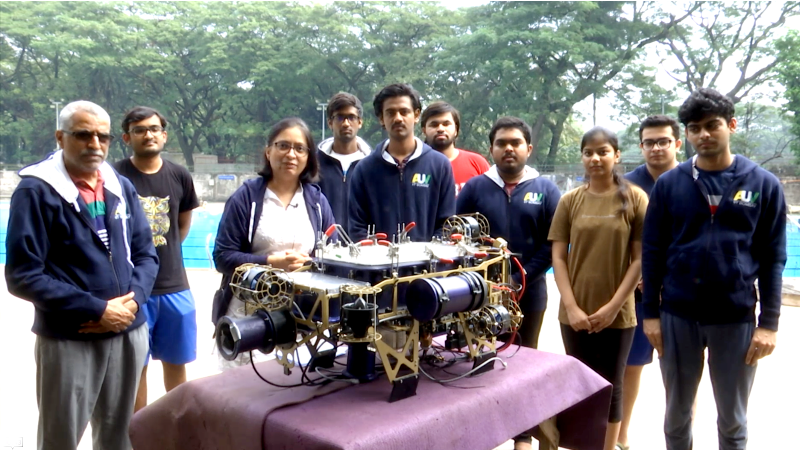
Autonomous underwater vehicles (AUV) have become an attractive alternative for underwater search and exploration because they are less expensive than conventional human-crewed vehicles and provide a reliable automated solution. AUVs are robots that do not need operator inputs to travel, navigate and perform tasks in water. They are used in oil and gas exploration in seas and ship hull inspection. They also help in oceanography, studying water bodies and creating seafloor maps. In the defence sector, they can detect mines and help in anti-submarine warfare.
Prof Leena Vachhani and Prof Hemendra Arya of Indian Institute of Technology Bombay and their students have designed and developed an entirely indigenous low-cost autonomous underwater vehicle named Matsya, a Sanskrit word for fish. The Matsya team includes undergrad students from multidisciplinary streams, working on mechanical engineering, electrical engineering, business and software aspects. Matsya AUV addresses the absence of indigenous and affordable technologies for support in challenging, disastrous and life-threatening situations where divers find it difficult or need assistance to reach. They can be utilised in situations such as floods, sunk submarines, oil leaks, missing objects, and regular time-consuming inspection tasks.
The Matsya can detect obstacles and avoid them, and thus, navigate obstacle-filled underwater arenas. It can determine its own location in the surroundings, termed localisation. It can also detect and shoot torpedoes at predefined targets (useful for defence applications). It can follow specific patterns on the arena floor (useful for the oil pipes or underwater fibre optic cables ). It can detect and hold underwater objects and locate underwater sound sources using sound-based guiding and tracking (similar to finding a black box of an aircraft). The Matsya AUV has won many accolades in national and international competitions, including the Robosub award, where international student teams compete in an underwater robotics program to build an AUV.
The Matsya vehicle has a well-knit network of mission planning, control and functional modules. The AUV has eight thrusters on it - three in the front and five at the back - that offer stability and better control to the AUV when put in water. Two cameras, one in the front and one at the bottom, help the vehicle see. The researchers have trained the cameras using state-of-the-art ML (machine learning) models on extensive custom data sets of underwater environments. The four hydrophones on the vehicle help it to hear. They collect the data, and then digital signal processing techniques are used to process the data received from the hydrophones and to isolate pings of different interests. The Matsya claims to have a manipulator arm capable of moving and lifting loads of up to 1 kg using a high torque motor. Two high-power batteries with a custom-designed battery management system power all the sensors, thrusters and other electronic components onboard the Matsya.
The team tests their algorithms and codes first on a custom-designed simulator and then in the waters of the swimming pool in the IIT Bombay campus or the sea. The simulator is designed to model various physical phenomena such as sea waves. The use of this simulator expedites the process of testing new design ideas. The team ensures that the individual parts are waterproof and performs pressure testing before assembling them into the final vehicle.
Matsya aligns with the Make in India and Atma Nirbhar Bharat vision. It is cost-effective as the entire software stack, and components’ interfaces are developed in-house, and the design is modular. Team Matsya has developed calibration, simulation, static and dynamic testing techniques for tuning controller and sensor parameters.
The latest version of Matsya is about one metre long, 0.4 metres broad, 0.6 metres high, and weighs about 37 kg. Modular design and testing techniques allow customising the Matsya design for various use-cases. Moreover, it is easy to deploy on-site because it is portable, robust, and easy to launch and recover. It has an entirely autonomous operation and intelligent interpretations of sensor data without needing any human intervention.
The system prototype has successfully performed tasks including shooting a torpedo, navigation, recognising patterns, and striking a buoy at the RoboSub 2019 at Transdec, San Diego, California, USA.
The team's knowledge about design, development, and testing of the AUV gained over a decade is transferred from senior to junior students. Each year, the group aims to improve the designs or add new functionalities. They have regular brainstorming sessions together. They also regularly carry out critical analysis and code reviews for all aspects of the vehicle to maintain quality.
Currently, the team is actively working with industry (Larsen & Toubro Pvt. Ltd.) to build a Remotely Operated Vehicle (ROV), under an initiative by the Government Of India, to be deployed in the sea for scanning and maintenance. Team Matsya is actively looking for potential underwater robotics and swarm-robotics projects. They also look forward to monetary support to fund these projects. Matsya can potentially offer more promising solutions in India in the niche space of AUV applications.
Editor’s Note: This is part of the special lab stories feature we are bringing to you.






